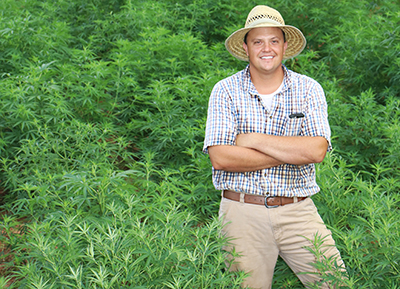High Hopes: Alabama Farmers Plant First Legal Hemp Crop

Over 100 Alabama farmers aren’t blowing smoke when they say hopes are high for hem
p — a crop in its first legal growing season.
While growers are working overtime to clarify misunderstandings about Cannabis sativa, they
also see high profit potential for hemp.
“The biggest misconception is that it’s marijuana,” said Crum Cook, who is growing 18 acres of hemp near Camden in Wilcox County. “First of all, I tell people it won’t get them high. Then I explain how THC has been bred out of the plants.”
Though hemp and marijuana are both cultivars of Cannabis sativa and look nearly identical their THC or tetrahydrocannabinol levels vary significantly.
Marijuana averages 20% THC, which is responsible for psychological effects. Legalized hemp production, which was authorized by the 2018 farm bill, requires that hemp have less than 0.3% THC.
Previously, the U.S. encouraged hemp farming during World War II’s Hemp For Victory campaign to produce critical goods for Allied soldiers.
Hemp has higher concentrations of CBD, or cannabidiol, an increasingly popular ingredient in the natural products industry. The green, thin-leaved plant is harvested for oil, which is diluted for therapeutic use, or fiber, which is processed into rope and textiles and a plethora of other products.
Some experts predict farmers could make upward of $100,000 per acre growing hemp.
But before harvest can begin, Alabama farmers are overcoming roadblocks, such as seed costs and labor.
Hemp seeds average $1-2 each, while transplants are $2-4 each. Transporting stock from established growers in states like Colorado, Tennessee and Virginia tacks on additional costs.
Alabama Farmers Federation President Jimmy Parnell has appointed a Hemp Advisory Committee to review policy for the state’s largest farm organization. Elmore County’s Joe Lambrecht chairs the committee. Members are Joel Sirmon, Baldwin County; Jim Lewey, Geneva County; Jackie Loyd, Jackson County; and Jason Lazenby, Lee County.
Federation commodity director Hunter McBrayer is the organization’s contact for hemp growers. He said challenges were expected for the inaugural crop.
“Alabama farmers are discovering the best techniques through trial and error and by contacting growers in other states,” McBrayer said. “It’s an expensive crop to grow, but the payoff could be tremendous due to the popularity of CBD and other hemp derivatives.”
New Frontier Data reported global hemp industry sales topped $1 billion in 2018, when farmers in just 24 states grew the crop. National sales are expected to more than double by 2022.
Hemp is a labor-intensive, hands-on crop since there are no labeled weed or pest suppressants, McBrayer noted.
Little hemp-specific equipment exists, causing farmers like Cook to retrofit machinery for planting and harvesting. Others spend hours and thousands of dollars to weed, water, prune and pick hemp by hand.
“Because I’m a cattle farmer, I’ve had to adjust to planting a crop like hemp as opposed to drilling grain for cows to graze,” said Cook, 31.
Cook raises stocker cattle and said hemp fit the bill when he was looking for a crop to fill the summer lull.
“Hemp grows best during the summer and is harvested about the time I need to plant my ryegrass and clover again,” he said.
Cook and many farmers are growing varieties prized for oil content. Around four months after planting, hemp is full, bushy and 4-5 feet high.
Alabama Department of Agriculture & Industries (ADAI) inspectors test the plants’ THC percentage before leaves and flowers are harvested and sent to the processor. Other farmers grow hemp 6-15 feet tall for fiber.
That’s where investors like Gordon Faulk come in. After years in the medical field, Faulk is one of 59 Alabamians licensed to process hemp through ADAI’s Industrial Hemp Research Pilot Program.
ADAI also licensed 157 growers and five universities to research hemp, including Alabama A&M University, Alabama State University, Troy University, Tuskegee University and the University of Alabama.
This year, most Alabama farmers will still haul hemp out of state since the Yellowhammer State’s processing facilities aren’t yet operational.
In Autauga County, Faulk, 72, is working with farmer Jason Johnson to learn the hemp-growing process. Johnson has 14 acres of hemp — about 15,000 plants — with his brothers, Jacob and Michael.
After installing a well, Johnson laid plastic mulch before transplanting hemp varieties to cut down on weed pressure.
“Our goal now is to keep the farm secure and the plants alive,” said Johnson, 43. “We’ve communicated with local law enforcement so they know what we’re growing out here. Once we get through this first year, we hope to increase our operation.”
McBrayer said he’s eager to evaluate hemp’s performance once the growing season rolls to a close around November.
“I’m cautiously optimistic,” he said. “This isn’t the first time a new, unusual crop has come to Alabama promising to make people a lot of money. It could be good for our farmers, but there are still a lot of challenges.”
